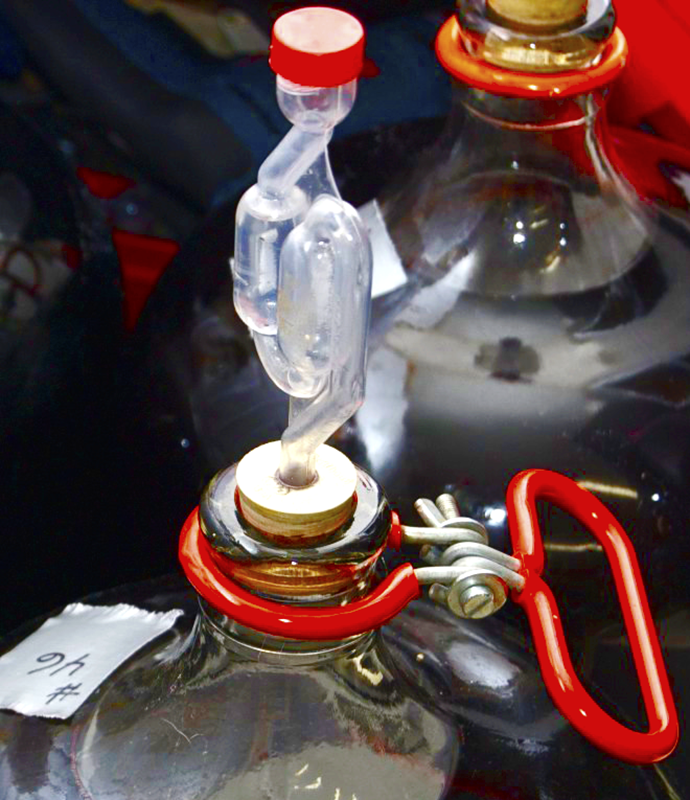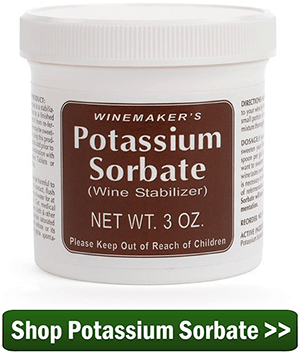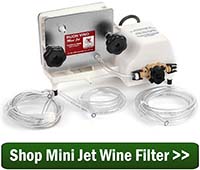 I have several 2 1/2 gallon jugs of wine going at this time started in December. The problem is – I am satisfied with the taste and the alcohol content however they won’t stop working. It seems like in the past, when I have allowed the wine to stop fermenting on its own, the taste changes? I have read that potassium sorbate does not completely kill off the yeast? What can I do to stop the ferment at this time and how much alcohol (brandy?) would I have to add to stop the ferment. Thanks.
I have several 2 1/2 gallon jugs of wine going at this time started in December. The problem is – I am satisfied with the taste and the alcohol content however they won’t stop working. It seems like in the past, when I have allowed the wine to stop fermenting on its own, the taste changes? I have read that potassium sorbate does not completely kill off the yeast? What can I do to stop the ferment at this time and how much alcohol (brandy?) would I have to add to stop the ferment. Thanks.
Name: Skip K.
State: MN
—–
Hello Skip,
The first thing I’d like to point out is that stopping a wine fermentation is not normal. What is normal is letting the wine fermentation continue until all the sugars in the wine must have been consumed by the wine yeast. If you prefer your homemade wines sweet, you would add sugar to taste at bottling time, and then add potassium sorbate to eliminate a chance of re-fermentation in the wine bottle.
What also is not normal is having a wine fermentation continue on for months. A typical wine fermentation will last anywhere from 5 days to two weeks. The fact that yours has lasted for months tells me that there is something fundamentally wrong.
I would suggest taking a look at the Top 10 Reasons For Fermentation Failure that is listed on our website. It runs through the most common reasons for a wine fermentation to either fail to start or to drag out, such as the case with yours. See if any of the top 10 reasons ring true to your situation. Now on to your question…
What can I do to stop a wine fermentation?
Well, what you can’t do is use either sulfites such as Campden tablets or use stabilizers such as potassium sorbate. Neither of these will stop a wine fermentation with any dependable success. Here’s why:
- Sulfites (Campden tablets, sodium metabisulfite, potassium metabisulfite):

Wine yeast are bred in such a way as to be acclimated to sulfites. They can withstand the levels that are typically present after a dose has been added to a wine. It is true that if a wine fermentation is on the verge of stopping anyway – for whatever reason – that a dose of sulfite can hasten its ending, but not with any predictable consistency. If a dose of sulfite is added to a fully active wine fermentation, you may see it slow down, maybe even to a crawl, but it would then eventually recover and go on to completion, but usually at a annoyingly slower pace than before. What happens is the sulfite will kill a portion of the yeast cells, stunting the fermentation activity, but then the wine yeast would slowly begin to recolonize and continue on with the task at hand.
- Potassium Sorbate:
 Adding potassium sorbate to a wine fermentation will not hinder it in any way. What it will do is stop a wine yeast colony from regenerating itself. The potassium sorbate puts a coating on the yeast cells that make it incapable of reproducing itself. In other words, it makes the wine yeast sterile. This makes potassium sorbate an effective ingredient to add to a wine that is already clear but may have some trace amounts of wine yeast still in it. If you sweeten that wine before bottling, the potassium sorbate will eliminate any chance of these few yeast cells from growing into large enough numbers to create a fermentation within the wine bottles.
Adding potassium sorbate to a wine fermentation will not hinder it in any way. What it will do is stop a wine yeast colony from regenerating itself. The potassium sorbate puts a coating on the yeast cells that make it incapable of reproducing itself. In other words, it makes the wine yeast sterile. This makes potassium sorbate an effective ingredient to add to a wine that is already clear but may have some trace amounts of wine yeast still in it. If you sweeten that wine before bottling, the potassium sorbate will eliminate any chance of these few yeast cells from growing into large enough numbers to create a fermentation within the wine bottles.
As you suggested, you could add alcohol to the wine to stop the wine fermentation. This is known as fortifying the wine. But you would need to get the alcohol level up to about 20% for this purpose. Brandy is typically used for this. It should be noted that this will dramatically change the wine’s flavor. The wine will seem less fruity as the alcohol level rises.
If you absolutely, positively, without question, must stop a wine fermentation in midstream, here’s how a winery would do it:
- Chill Down The Fermenting Wine:
The cooler the better, but 50°F. is sufficient. This will stop the wine fermentation, and the wine yeast will slowly begin to settle to the bottom. You may also want to add bentonite while chilling the wine to help the wine yeast clear out faster and more thoroughly.
- Rack The Wine Off The Sediment:
Give the wine plenty of time to clear up before racking it. Technically, it is possible to rack the wine in as soon as 5 days, but it is much better to wait a couple of weeks. You could get extra solids precipitating out of the wine during this extra time such as acid crystals. That would be a good thing.
- Filter The Wine:

When I say filter the wine, I do not mean to drip it through some cheese cloth or a coffee filter or something along this line. You need to be able to put it through an actual wine filter that will filter fine enough to remove any leftover yeast cells. This means filtering down to .5 microns in size. A coffee filter only filters down to about 20 to 25 microns. A .5 micron filter pad will remove over 99.9% of the wine yeast in a wine and is considered sterile. Depending on how much tannin is in the wine, you may need to put the wine through a more coarse filter pad first. I always filter through a 1 micron filter pad before attempting to run the wine through a .5 micron filter pad. This eliminates the chance of the filter pad being clogging up with wine solids.
So there you have it: how to stop a wine fermentation. My personal opinion is that the effort is not worth it from an individual winemaker’s perspective. It is much less work to let the wine fermentation complete on its own, then deal with adjusting the sweetness to your liking.
Happy Winemaking,
Ed Kraus
—–
Ed Kraus is a 3rd generation home brewer/winemaker and has been an owner of E. C. Kraus since 1999. He has been helping individuals make better wine and beer for over 25 years.

My red wines will sometimes produce bubbles in the airlocks for two months but I ascribe the later activity to malolactic conversion.
Hey, my SG seems to be stuck at 1.06. I’m making muscadine wine and the wine has cleared and is about 3 months old. Racked wine for the 3rd time today. Any help or ideas.
Thanks
Donna, there are a number of reasons that can cause a stuck fermentation. I would take a look at the following article containing the most common reasons to see which might apply to your situation. Before you can fix the problem, you need to know what caused it to become stuck.
Top Reasons For Fermentation Failure
http://www.eckraus.com/wine-making-failure
If Wine is normally 8%-12% alcohol and lasts about 2 years or needs to be kept chilled or it may spoil or turn to vinegar, how is it that wines 25 years old are coveted, and do not spoil or change to vinegar. Thank you for all your help, Echota
Harry, wines that have had sulfites added to them (which is almost all wines) can keep for decades. They will not turn to vinegar or spoil. The biggest concern is that the flavor will age out over time, leaving the wine flat and flabby. Certain full-bodied reds can still test good after 25 years but this is a rarity. Most wines are at their best around 3 to 6 years.
Many of my wine batches continue fermenting for months. I’ve had very few stop at one month. I’ve had a few bottles explode, sometines it’s still active when I bottle it sometines it’s a wild yeast. I refuse to add chemicals to my wine so my solution is to pasteurize it. 140 f. for 20 minutes will stop all fermetations and kill bacteria and wild yeast. I can’t tell the difference in the taste. The chemicals give me a headache and a hangover, myself and friends noticed that soon after making our own wine. a whole bottle of commercial wine will always give me a hangover, even a half bottle, but my all natural wines don’t even if I drink 2 bottles. Most of my wine ranges fron 10 to 12% alcohol and I like semi-sweet. The hydrometer will show .992 to 1.000 specific gravity on most of my wines but they are still semi-sweet to sweet, I think it’s the fruit, I never make grape wines, but many kinds of fruit wines. Plum is a good one.
I find it difficult to maintain the wine flavour after pasteurizing. Even though the ethanol boiling point is over 190 degrees Fahrenheit, there would be significant evaporation and a high risk of increased oxidation unless it is done in a closed environment.
Great info..
I have tried adding sugar to a dry wine. The taste is simply not the same as 1. using a low alcohol tolerance yeast in order to get sweeter wine. 2. I prefer this method, I blend a sweet wine, above SG of 1.000 with a dry wine SG of .988-.994 in order to achieve the desired SG, which in my case is always .996. I have tested a lot of commercial wines and find that many of them have an SG of .996.
Bill I think all your inputs are significantly valuable. I’m a young self-taught winemaker. With only one harvest under my belt, do you have any resources I can read in order for me to more comfortable around the cellar. I run my own cellar and I only make natural wines.
Blurry topics for me are:
– Knowing what Brix to harvest grapes at in order to accentuate acidity or tannin structure ie. picking grapes either for freshness (acidity) or for tannin length.
– Keeping out harmful bacteria when executing whole bunch fermentation
– executing whole bunch fermentation without ruining the wine or exposing it to ruinous bacteria
– sterilisation (chemicals to use to clean cellar equipment and thecellar environment without killing off natural yeast)
– stabilisation, ie. knowing when my wine is stable enough to bottle without using a microscope. Gravity/ Alc readings aside, I’m more concerned with the biochemistry aspect especially with latent yeast/bacteria that could be lingering undetected.
– chemicals to use in sterilising bottle prior to bottling